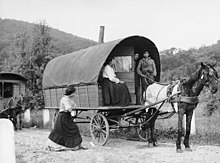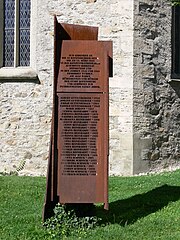Sinti
| Total population | |
|---|---|
| ≈ 200,000[1] | |
| Languages | |
| Sinte Romani |
| Part of a series on |
| Romani people |
|---|
|
show
Romani people by sub-group |
|
show
Romani diaspora by country |
|

The Sinti (also Sinta or Sinte; masc. sing. Sinto; fem. sing. Sintesa) are a Romani people in Central Europe that number around 200,000 people.[1] They were traditionally itinerant, but today only a small percentage of Sinti remain unsettled. In earlier times, they frequently lived on the outskirts of communities. The Sinti of Central Europe (mostly Germany) are closely related to the group known as Manouche in France.[2] They speak the Sinti-Manouche variety of Romani, which exhibits strong German influence.[1][2] They were first mentioned outside Sindh in 1100 by the Arab chronicler Meidani, and are an ethno-linguistic group that is one of the oldest Indian Subcontinent diasporas in Europe.[3]
Name[]
The origin of the name is disputed. Some, including many Sinti themselves, believe it derives from Sindhi, the name of a people of Sindh (a region in Pakistan), based on indications that Romani peoples originated in the Indian subcontinent.[4][5] Others, including scholar Yaron Matras, argue that "Sinti" is a later term in use by the Sinti from only the 18th century on, and is likely a European loanword.[6][4] A recent study by Estonian and Indian researchers found genetic similarities between European Romani men and Indian men in their sample.[7] Linguist N. B. G. Kazi believes that Sinti are from Sindh.[8]
Some other possible locations, where the name Sinti derived from are the Sindh River or the Sind River or Kali Sindh River. Maybe also derived from Sind Valley or the Indus River in sanskrit named sindhu, or the village Sinthee. Other Sinti groups claim their ancestors are the Sindi people came to Europe much earlier and appear as Sintians in Sintice now Sintiki, where their language Sintitikes derived from.
History[]
The Sinti are a subgroup of Romani people mostly found in Germany.[9] They arrived in Austria and Germany in the Late Middle Ages as part of the Romani emigration from the Indian Subcontinent,[10] eventually splitting into two groups: Eftavagarja ("the Seven Caravans") and Estraxarja ("from Austria").[11] They arrived in Germany before 1540.[12] The two groups expanded, the Eftavagarja into France, Portugal and Brazil, where they are called "Manouches", and the Estraxarja into Italy and Central Europe, mainly what are now Croatia, Slovenia, Hungary, Romania,[dubious ] the Czech Republic and Slovakia, eventually adopting various regional names.[13] In Italy they are present mainly in Piedmont region (where in Piedmontese they are called Sinto, although the word for Romani people is sìngher, as the Italian zingari), with some communities in Veneto and Emilia Romagna as well.
The Holocaust[]

The Sinti migrated to Germany in the early 15th century. Despite their long presence, they were still generally regarded as beggars and thieves, and, by 1899, the police kept a central register on Sinti, Roma, and Yeniche peoples. The National Socialists considered them racially inferior (see Nazism and race), and persecuted them throughout Germany during the Nazi period—the Nuremberg Laws of 1935 often being interpreted to apply to them as well as the Jews.[14]
Adolf Eichmann recommended that the Third Reich solve the "Gypsy Question" simultaneously with the Jewish Question, resulting in the deportation of the Sinti to clear room to build homes for ethnic Germans.[15] Some were sent to Poland, or elsewhere (including some deported to Yugoslavia by the Hamburg Police in 1939[16]) others were confined to designated areas, and many were eventually murdered in gas chambers.[17] Many Sinti and Roma were taken to Auschwitz-Birkenau, where they were put in a special section, called the "gypsy camp". Dr. Josef Mengele often performed some of his infamous experiments on Sinti and Roma. On 2 August 1944 the "gypsy camp" was closed, and approximately 4,000 Sinti and Roma were gassed during the night of 2–3 August and burnt in the crematoria. 2 August is now commemorated as Roma and Sinti Holocaust Remembrance Day.[citation needed][18]

In the concentration camps, the Sinti were forced to wear either a black triangle, indicating their classification as "asocial",[19] or a brown triangle, specifically reserved for Sinti, Roma, and Yeniche peoples.

Deportation of Sinti and Roma in Asperg, 22 May 1940
Memorial for murdered Sinti in Düsseldorf-Lierenfeld

Ravensburg, Memorial for Sinti murdered in Auschwitz
See also[]
- History of the Romani people
- Romani people by country
- Sindhi diaspora
- Sinte Romani (language)
- Antiziganism
- Romani people in Germany
References[]
- ^ Jump up to: a b c Grimes, Barbara F. (May 2003). "Central Indo-Aryan Languages". In Frawley, William (ed.). International Encyclopedia of Linguistics. 1 (2nd ed.). New York City: Oxford University Press. p. 295. doi:10.1093/acref/9780195139778.001.0001. ISBN 978-0-19-513977-8.
- ^ Jump up to: a b Margalit, Gilad; Matras, Yaron (2007). "Gypsies in Germany-German Gypsies? Identity and Politics of Sinti and Roma in Germany". In Stauber, Roni; Vago, Raphael (eds.). The Roma: A Minority in Europe: Historical, Political and Social Perspectives. Budapest: Central European University Press. pp. 103–116. ISBN 978-1-4294-6253-2. OCLC 191940451.
- ^ DiRrrichardi Reichard, Rinaldo (1 January 2013). A CRISIS OF ETHNIC IDENTITY BORN A GYPSY – SINTO, MUST I NOW BECOME A ROMANI?. LJUBLJANA. ASIN B00IQROXRA.
- ^ Jump up to: a b Yaron Matras, "The Role of Language in Mystifying and Demystifying Gypsy Identity" in: Nicholas Saul, Susan Tebbutt, The Role of the Romanies: Images and Counter-images of "Gypsies"/Romanies in European Cultures, Liverpool University Press (2004), ISBN 978-0-85323-679-5, p. 70.
- ^ Kochanowski, Jan (1968). Lisa Pasternak Slater (translator). "Black Gypsies, White Gypsies: The Gypsies Within the Perspective of Indo-European Migrations". Diogenes. 16 (63): 27–47. doi:10.1177/039219216801606302. S2CID 144991150.
- ^ Margalit, Gilad; Matras, Yaron (2007). "Gypsies in Germany-German Gypsies? Identity and Politics of Sinti and Roma in German". In Stauber, Roni; Vago, Raphael (eds.). The Roma: A Minority in Europe: Historical, Political and Social Perspectives. Budapest: Central European University Press. p. 105. ISBN 978-1-4294-6253-2. OCLC 191940451.
[U]p to the late 18th century the Sinti referred to themselves as ‘Kale’ (lit. ‘blacks’). The term ‘Sinti’ or ‘Sinte’ (see below) may be found in 18th and 19th century linguistic documentation alongside ‘Kale,’ and appears to have been borrowed from the secret vocabulary of the Yenish travelers, perhaps because of its usefulness in concealing ethnic identity. Only toward the late 19th century does the self-appellation ‘Sinti’ replace ‘Kale’ entirely in Germany.
- ^ Nelson, Dean (3 December 2012). "European Roma descended from Indian 'untouchables', genetic study shows". Telegraph.co.uk. Retrieved 15 December 2017.
- ^ "HYDERABAD, Gypsies hail from Sindh, claims Dr.Kazi". DAWN. 25 September 2006. Retrieved 7 March 2021.
- ^ Kalaydjieva, Luba; Gresham, David; Calafell, Francesc (2 April 2001). "Genetic studies of the Roma (Gypsies): A Review". BioMed Central Medical Genetics. 2 (5): 5. doi:10.1186/1471-2350-2-5. PMC 31389. PMID 11299048.
Individual groups can be classified into major metagroups: the Roma of East European extraction; the Sinti in Germany and Manouches in France and Catalonia; the Kaló in Spain, Ciganos in Portugal and Gitans of southern France; and the Romanichals of Britain.
- ^ "Europe invented 'gypsies,' says German author". Deutsche Welle. Retrieved 15 March 2014.
- ^ Innsbrucker Beiträge zur Kulturwissenschaft: Sonderheft. 1993. ISBN 978-3-85124-165-5.
- ^ Nicholas Saul, Susan Tebbutt, p. 182
- ^ Szombati, Kristóf (June 12, 2018). The Revolt of the Provinces: Anti-Gypsyism and Right-Wing Politics in Hungary. Berghahn Books. ISBN 978-1-78533-897-7 – via Google Books.
- ^ "Targeting the Sinti and Roma". Retrieved June 13, 2021.
- ^ Burleigh, The Racial State, p. 122.
- ^ Michael Burleigh and Wolfgang Wipperman, The Racial State: Germany 1933–1945 (Cambridge, England: Cambridge University Press, 2002), 117.
- ^ Davis, Mark (5 May 2015). "How World War II shaped modern Germany". euronews.
- ^ "European Roma Holocaust Memorial Day: Statement by President von der Leyen, Vice-President Jourová and Commissioner Dalli". European Commission. Archived from the original on 26 May 2021. Retrieved 22 May 2021.
- ^ Shapiro, Paul A.; Ehrenreich, Robert M. (2002). "brown+triangle" Roma and Sinti: under-studied victims of Nazism: symposium proceedings. Center for Advanced Holocaust Studies, United States Holocaust Memorial Museum. p. 24. Retrieved 2010-06-26.
Bibliography[]
- Susan Tebbutt, Nicholas Saul; Tebbutt, Susan (2004). The role of the Romanies : images and counter-images of 'Gypsies'/Romanies in European cultures. Liverpool: Liverpool Univ. Press. ISBN 978-0-85323-679-5.
Further reading[]
- Walter Winter, Struan Robertson (translator). Winter Time: Memoirs of a German Who Survived Auschwitz. Hertfordshire Publications, (2004), ISBN 1-902806-38-7.
- Reviewed by Emma Brockes "We had the same pain" in The Guardian November 29, 2004.
Sinti and Roma: Gypsies in German-speaking Society and Literature
Sinti and Roma: Legal Status and Perspectives for a European Minority
Roma in Europe: The Politics of Collective Identity Formation
External links[]
 Media related to Roma people at Wikimedia Commons
Media related to Roma people at Wikimedia Commons- Non-Jewish Victims of Persecution in Nazi Germany on the Yad Vashem website
- Wege nach Ravensbrück (Ravensbrück concentration camp: Memories of surviving female Sinti) (in German)
- F. N. Finck, Lehrbuch des Dialekts der deutschen Zigeuner (1903) on Internet Archive (in German)
- https://www.amazon.com/Sinti-Roma-Gypsies-German-speaking-Literature/dp/1571819215
- https://books.openedition.org/ceup/1417?lang=en
- https://www.ushmm.org/m/pdfs/2000926-Roma-and-Sinti.pdf
- https://www.ushmm.org/collections/bibliography/sinti-and-roma-gypsies
- https://minorityrights.org/minorities/romasinti/
- http://fcit.usf.edu/holocaust/people/ushmmrom.htm
- Sinti
- Romani groups
- Romani in Europe
- Romani in Germany
- Ethnic groups in Germany


